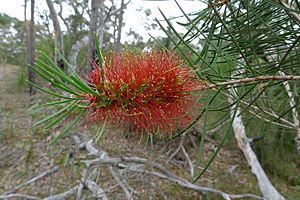Narrow-leaved bottlebrush facts for kids
Quick facts for kids Narrow-leaved bottlebrush |
|
|---|---|
 |
|
| Melaleuca linearis in the Royal National Park | |
| Scientific classification | |
| Genus: |
Melaleuca
|
| Species: |
linearis
|
| Synonyms | |
|
|
Melaleuca linearis, often called the narrow-leaved bottlebrush, is a special plant found only in New South Wales and Queensland in Australia. It belongs to the Myrtaceae family, which is also known as the myrtle family. Some people still use its older names, like Callistemon linearis. This plant is a medium-sized shrub. It has narrow leaves with a stiff, pointed tip. Its bright red flowers, which look like a bottlebrush, usually appear in late spring or early summer.
Contents
What Does It Look Like?
The narrow-leaved bottlebrush is a shrub that can grow up to about 3 meters (10 feet) tall. It has grey, hard, and fibrous bark. Its leaves are arranged one after another along the stem. They are quite long, usually between 3.5 and 11.5 centimeters (1.4 to 4.5 inches) long. The leaves are very narrow, only about 0.7 to 2.7 millimeters (0.03 to 0.1 inches) wide. They can be flat, grooved, or even half-round in shape. You can see a main vein in the middle of the leaf, but the other veins are hard to spot.
Flowers and Fruits
The flowers of this plant are usually red, but sometimes they can be green. They grow in spikes at the ends of branches. These branches keep growing even after the flowers have bloomed. Flowers can also appear on the sides of the branches. Each flower spike is about 4 to 6.5 centimeters (1.6 to 2.6 inches) across and 5 to 10 centimeters (2 to 4 inches) long. There can be anywhere from 20 to 90 individual flowers on one spike!
Each flower has petals that are about 3.2 to 7 millimeters (0.1 to 0.3 inches) long. These petals fall off as the flower gets older. Inside each flower, there are many stamens, which are the parts that produce pollen. There can be between 23 and 73 stamens per flower. The plant flowers from late spring to early summer. After the flowers, the plant produces woody fruits called capsules. These capsules are about 3.8 to 8.2 millimeters (0.15 to 0.32 inches) long.
Plant Names and History
Melaleuca linearis was first officially described in 1796. Two botanists, Heinrich Schrader and Johann Christoph Wendland, wrote about it in a book called Sertum Hannoveranum. The second part of its scientific name, linearis, comes from a Latin word that means "linear" or "line-like." This refers to the very thin, straight shape of the plant's leaves.
This plant is sometimes known by different names. For a long time, it was called Callistemon linearis. Other names you might hear are Callistemon pinifolius or Callistemon rigidus. Even today, some plant collections in Australia still use these older names.
Where It Grows
The narrow-leaved bottlebrush grows in the southeastern part of Queensland. In New South Wales, you can find it from Nowra on the south coast, stretching inland as far as Gilgandra. It likes to grow in damp places and can be found in different types of plant communities.
Growing This Plant in Gardens
People have been growing Melaleuca linearis in gardens for a long time. It was often known by its older names like Callistemon linearis. Even though it's not super common in home gardens, it's a very tough plant. It can grow well in most types of soil, but it prefers to be in a spot where it gets lots of sunshine. This plant is also quite good at resisting common garden pests, like the sawfly, which can bother other similar plants. Because it's so hardy and beautiful, it has even received an award called the Royal Horticultural Society's Award of Garden Merit.
Images for kids



